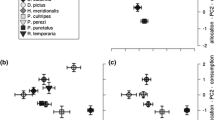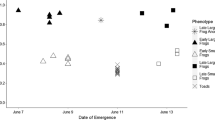Abstract
A tradeoff affecting the ability to grow under high versus low resource levels has been commonly hypothesized to influence species distributions across resource gradients in a wide variety of taxa. This influence is dependent on individual growth being proportional to traits that affect demographic processes such as mortality. However, data on how individual growth scales with demographic performance are rare. We conducted a mesocosm experiment, and re-analyzed data from a similarly designed field experiment, to examine the relationship between growth and mortality in two tadpole species that segregate across a resource gradient. Overall, environmental conditions leading to faster growth also lead to lower mortality rates. However, species differed in this relationship. Leopard frogs achieved faster growth than wood frogs, but their absolute mortality was greater and increased steeply as growth decreased. Conversely, absolute mortality of wood frogs was lower and less strongly dependent on growth. These interspecific differences suggest a second tradeoff, that between maximizing growth rates or minimizing mortality, with potentially important demographic consequences. Leopard frogs grow faster than wood frogs in productive ponds, but are excluded from unproductive ponds dominated by wood frogs due to accelerating mortality rates with declining realized growth. A review of the literature suggests that in diverse taxa, including plants, microcrustaceans and drosophilids, patterns in mortality are consistent with this tradeoff indicating that the mechanism we demonstrate could be a link between individual performance and demographic rates influencing species distributions in other systems.


Similar content being viewed by others
References
Arendt JD (1997) Adaptive intrinsic growth rates: an integration across taxa. Q Rev Biol 72:149–177
Arendt JD, Wilson DS, Stark E (2001) Scale strength as a cost of rapid growth in sunfish. Oikos 93:95–100
Augspurger CK (1984a) Light requirements of neotropical tree seedlings: a comparative study of growth and survival. J Ecol 72:777–795
Augspurger CK (1984b) Seedling survival of tropical tree species: interactions of dispersal distance, light-gaps, and pathogens. Ecology 65:1705–1712
Berven KA (1990) Factors affecting population fluctuations in larval and adult stages of the wood frog (Rana sylvatica). Ecology 71:1599–1608
Blanckenhorn WU (1998) Adaptive phenotypic plasticity in growth, development, and body size in the yellow dung fly. Evolution 52:1394–1407
Brokaw N (1980) Gap-phase regeneration in a neotropical forest. PhD dissertation, University of Chicago, Chicago, Ill.
Collins JP (1975) A comparative study of the life history strategies in a community of frogs. PhD dissertation, University of Michigan, Mich.
Connell JH (1975) Some mechanisms producing structure in natural communities: a model and evidence from field experiments. In: Cody ML, Diamond JM (eds) Ecology and evolution of communities. Belknap Press of Harvard University Press, Cambridge, Mass., pp 460–490
Denver RJ, Glennemeier KA, Boorse GC (2002) Endocrinology of complex life cycles: amphibians. In: Pfaff D, Arnold A, Etgen A, Fahrbach S, Rubin R (eds) Hormones, brain and behavior, vol 2. Academic Press, San Diego, Calif., pp 469–513
Desmarais KH, Tessier AJ (1999) Performance trade-off across a natural resource gradient. Oecologia 120:137–146
Dudycha JL (2001) The senescence of Daphnia from risky and safe habitats. Ecol Lett 4:102–105
Dudycha JL, Tessier AJ (1999) Natural genetic variation of life span, reproduction, and juvenile growth in Daphnia. Evolution 53:1744–1756
Ellison AM, Denslow JS, Loiselle BA, Brenez MD (1993) Field and seedling ecology of neotropical Melastomataceae. Ecology 74:1733–1749
Glennemeier KA, Denver RJ (2002) Role for corticoids in mediating the response of Rana pipiens tadpoles to intraspecific competition. J Exp Zool 292:32–42
Gosner KL (1960) A simplified table for staging anuran embryos and larvae, with notes on identification. Herpetologica 16:183–190
Grime JP (1979) Plant strategies and vegetation processes. Wiley, New York
Grime JP, Hunt R (1975) Relative growth rate: its range and adaptive significance in a local flora. J Ecol 63:393–422
Grime JP, Thompson K, Hunt R, Hodgson JG, Cornelissen JHC, Rorison IH, Hendry GAF, Ashenden TW, Askew AP, Band SR, Booth RE, Bossard CC, Campbell BD, Cooper JEL, Davison AW, Gupta PL, Hall W, Hand DW, Hannah MA, Hillier SH, Hodkinson DJ, Jalili A, Liu Z, Mackey JML, Matthews N, Mowforth MA, Neal AM, Reader RJ, Reiling K, Ross-Fraser W, Spencer RE, Sutton F, Tasker DE, Thorpe PC, Whitehouse J (1997) Integrated screening validates primary axes of specialization in plants. Oikos 79:259–281
Hubbell SP (2001) The unified neutral theory of biodiversity and biogeography. Princeton University Press, Princeton, N.J.
Kitajima K (1994) Relative importance of photosynthetic traits and allocation patterns as correlates of seedling shade tolerance of 13 tropical trees. Oecologia 98:419–428
Kobe RK (1997) Carbohydrate allocation to storage as a basis of interspecific variation in sapling survivorship and growth. Oikos 80:226–233
Kobe RK (1999) Light gradient partitioning among tropical tree species through differential seedling mortality and growth. Ecology 80:187–201
Kobe RK, Coates KD (1997) Models of sapling mortality as a function of growth to characterize interspecific variation in shade tolerance of eight tree species of northwestern British Columbia. Can J For Res 27:227–236
Kobe RK, Pacala SW, Silander JA Jr (1995) Juvenile tree survivorship as a component of shade tolerance. Ecol Appl 5:517–532
Krijger CL, Peters YC, Sevenster JG (2001) Competitive ability of neotropical Drosophila predicted from larval development times. Oikos 92:325–332
Lankford TE Jr, Billerbeck JM, Conover DO (2001) Evolution of intrinsic growth and energy acquisition rates. II. Trade-offs with vulnerability to predation in Menidia menidia. Evolution 55:1873–1881
Relyea RA (2001) The relationship between predation risk and antipredator responses in larval anurans. Ecology 82:541–554
Rollins-Smith LA, Cohen N (1996) Metamorphosis: an immunologically unique period in the life of the frog. In: Gilbert LI, Tata JR, Atkinson BG (eds) Metamorphosis: post embryonic reprogramming of gene expression in amphibian and insect cells. Academic Press, San Diego, Calif., pp 626–646
Schiesari L (2004) Performance tradeoffs across resource gradients in anuran larvae. PhD dissertation, University of Michigan, Mich.
Schiesari L (2006) Pond canopy cover: a resource gradient for anuran larvae. Freshwater Biol 51:412–423
Sevenster JG, van Alphen JJM (1993) A life history trade-off in Drosophila species and community structure in variable environments. J Anim Ecol 62:720–736
Skelly DK, Werner EE, Cortwright SA (1999) Long-term distributional dynamics of a Michigan amphibian assemblage. Ecology 80:2326–2337
Skelly DK, Freidenburg LK, Kiesecker JM (2002) Forest canopy and the performance of larval amphibians. Ecology 83:983–992
Stemberger RS, Gilbert JJ (1985) Body size, food concentration, and population growth in planktonic rotifers. Ecology 66:1151–1159
Suding KN, Goldberg DE, Hartman KM (2003) Relationships among species traits: separating levels of response and identifying linkages to abundance. Ecology 84:1–16
Tessier A.J, Woodruff P (2002) Trading off the ability to exploit rich versus poor food quality. Ecol Lett 5:685–692
Tessier AJ, Leibold MA, Tsao J (2000) A fundamental tradeoff in resource exploitation by Daphnia and consequences to plankton communities. Ecology 81:826–841
Tilman D (1990) Constraints and tradeoffs: toward a predictive theory of competition and succession. Oikos 58:3–15
Verbeke G, Molenberghs G (2002) Linear mixed models for longitudinal data. Springer, Berlin Heidelberg New York
Werner EE, Anholt BR (1993) Ecological consequences of the trade-off between growth and mortality rates mediated by foraging activity. Am Nat 142:242–272
Werner EE, Glennemeier K (1999) The influence of forest canopy cover on the breeding pond distributions of several amphibian species. Copeia 1:1–12
Wright AH (1914) North American Anura—life histories of the Anura of Ithaca, New York. Carnegie Inst Wash Publ 197:1–98
Acknowledgements
We thank Zack Schulman for field assistance, Faye Stoner of the Washtenaw County Parks and the Michigan DNR for egg collection permits, and the University of Michigan’s Museum of Zoology for permission to work in the E. S. George Reserve. Insightful comments of Deborah Goldberg and Katie Nash-Suding, and statistical advice by Kathy Welch and Laura Klem were particularly important for the development of this research. This research was funded by the Conselho Nacional de Desenvolvimento Científico e Tecnológico of the Brazilian Government (CNPq 200093/97–5), The University of Michigan (Rackham Predoctoral Fellowship), and the National Science Foundation (DEB-0089809). S. D. P. acknowledges support from the Michigan Agricultural Experimental Station. This is GLERL contribution 1384. The experiment reported here complies with all current laws of the USA.
Author information
Authors and Affiliations
Corresponding author
Additional information
Communicated by Steven Kohler
Rights and permissions
About this article
Cite this article
Schiesari, L., Peacor, S.D. & Werner, E.E. The growth–mortality tradeoff: evidence from anuran larvae and consequences for species distributions. Oecologia 149, 194–202 (2006). https://doi.org/10.1007/s00442-006-0440-1
Received:
Accepted:
Published:
Issue Date:
DOI: https://doi.org/10.1007/s00442-006-0440-1




